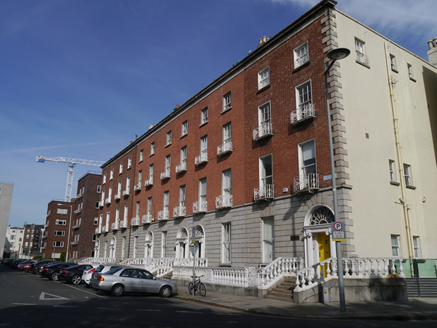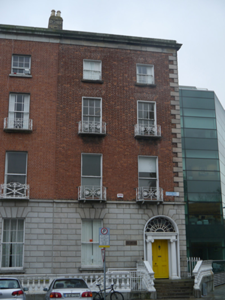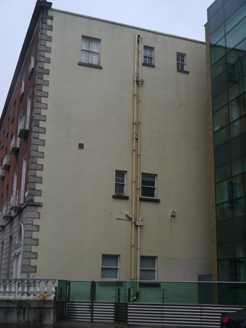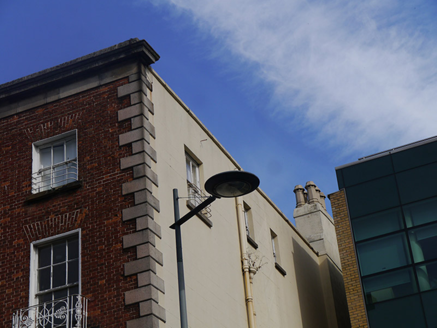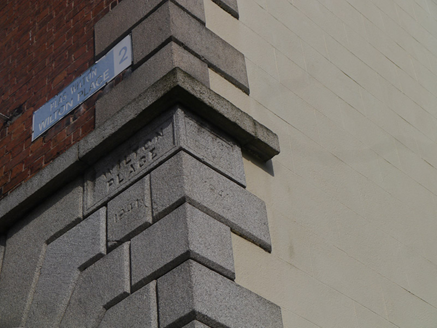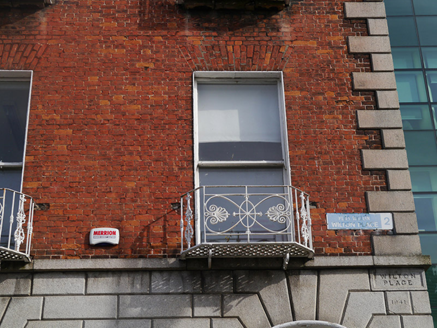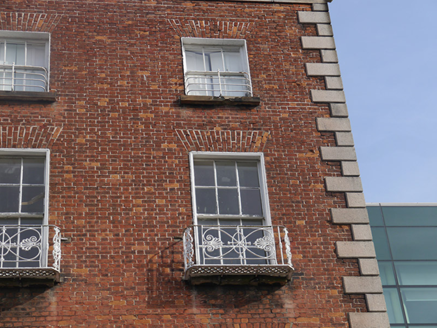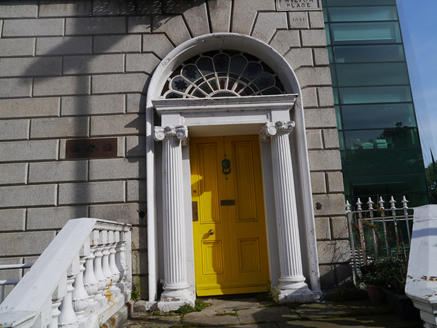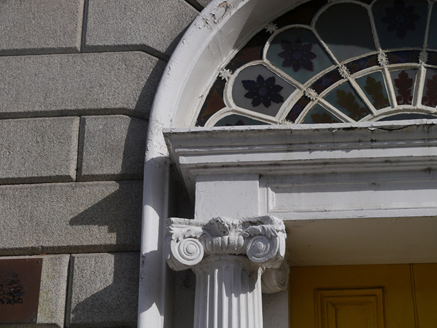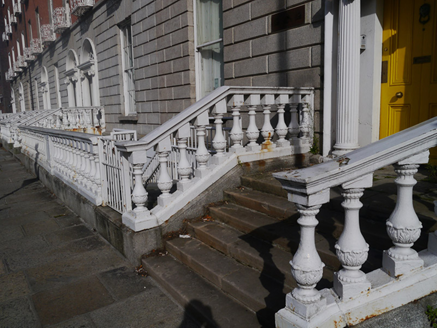Survey Data
Reg No
50930186
Rating
Regional
Categories of Special Interest
Architectural, Artistic
Original Use
House
In Use As
Office
Date
1840 - 1845
Coordinates
316806, 232940
Date Recorded
29/09/2015
Date Updated
--/--/--
Description
Corner-sited end-of-terrace two-bay four-storey former townhouse over basement, dated 1841, built as a terrace comprising Nos. 1-6 (50930186-91). Now in use as offices. Pitched roof to front (south) pile, hipped to east-end, with irregular M-profile hipped roof to rear (north) pile with ridge running perpendicular to street. Brick chimneystacks with lipped yellow clay pots to west party wall, rendered chimneystack to east with octagonal clay pots. Roof concealed behind ashlar granite-faced parapet with moulded granite cornice and blocking course, that to east elevation rendered with plain painted masonry coping. Parapet gutters with cast-iron hoppers and downpipes breaking through to east elevation. Red brick walling laid in Flemish bond to principal (south) elevation with rusticated granite walling to ground floor over offset granite plinth, and having rusticated granite quoins to south-east corner. Ruled-and-lined rendered walling to south basement and east elevation. Continuous granite sill courses to first floor with inscription over ground floor; ‘Wilton / Place / 1841’ to south and ‘Wilton / Terrace / 1841’ to east. Square-headed window openings with projecting masonry sills (some replacements), generally patent reveals (moulded to second floor) and brick voussoirs; granite surrounds to ground floor and rendered surrounds to basement and east elevation. Openings diminishing to upper floors, cast-iron balconettes affixed to second and first floor south windows, iron guard rails to third floor. Windows are multi-paned timber sliding sashes with variety of horns; one-over-one to ground and first floor (diminutive to east elevation), possibly original six-over-six to second floor, three-over-three to third floor, ten-over-ten to basement and pair of diminutive two-over-two to third floor east. Round-headed door opening to eastern bay of principal elevation with granite voussoirs, moulded rendered reveals and Neo-classical doorcase comprising fluted Scamozzian-Ionic columns on plinth stops rising to moulded cornice with panelled frieze. Ornate petal fanlight over with decorative stained glass and four-panelled timber door with beaded-muntin and brass furniture. Granite entrance platform with six steps to street flanked by masonry balustrade on granite plinth, enclosing basement wells to south elevation, and that to east angled with cast-iron pedestrian gate providing access to eastern basement well. Replacement steel pedestrian gate, steps and handrail to area. Rampant-arch-headed opening to south basement storage area extending beneath pavement. Street fronted on north side of Wilton Place, overlooking the Grand Canal to south and an enclosed park to the south-west.
Appraisal
One of a terrace of six, this former townhouse was originally intended to be part of a large-scale scheme, devised c. 1830 by Arthur Neville, for a crescent framing a semi-circular park, overlooking the Grand Canal. Delayed and then revised due to failed negotiations over land acquisition, the terrace was eventually built in 1841, with four houses constructed by George Farrell. One is attributed to Henry McManus. Characterised by granite rusticated ground floors, decorative iron balconettes, balustraded stone steps and good Scamozzian-Ionic doorcases, the terrace is largely well retained, despite some alterations and loss of historic fabric. The terrace defines much of the streetscape character of Wilton Place, and is the only realised section of a grand-scale mid-nineteenth century planning scheme.
